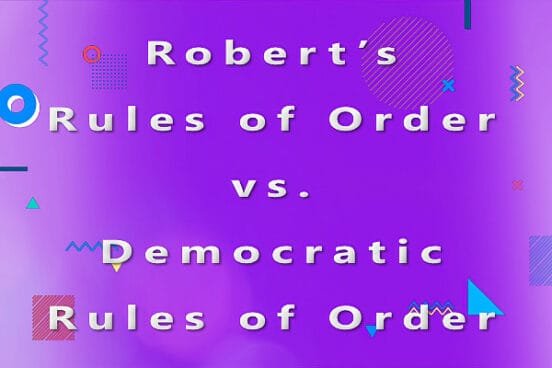According to information in the board packet, Chair Lloyd Sherman will propose an alternative to Roberts Rules of Order at the September 16, 2020 Board Meeting.
This article discusses the advantages and disadvantages of both systems, bringing to light the farreaching importance of this decision. Going forward, this is a decision the POA will most likely have to live with and the implications of this commitment are a little more complex than what appears on the surface. This article is not meant to suggest one system as being preferable over the other.
Robert’s Rules of Order is a manual of parliamentary procedure used for conducting meetings and making group decisions. It is the most commonly adopted parliamentary authority among societies in the United States.
HSVPOA Board Directors have always used Robert’s Rules of Order but are considering a simpler alternative.
Democratic Rules of Order are less complex
Democratic Rules of Order offer a less cumbersome and more easily understood set of meeting protocols and are therefore considered to be a fairer, more democratic way of running a meeting. Democratic Rules are also considered to be a more modern system. Using Democratic Rules of Order result in more participation by board members who may not have fully comprehended the unwieldy Robert’s Rules. Robert’s Rules are generally not understood by all members due to the complexity of the rules, while Democratic Rules are more easily understood by all members. Because Robert’s Rules are so complex it is important to have a Parliamentarian at the meetings when working under these rules.
Robert’s Rules of Order were originally penned in 1876 for the United States Congress. Democratic Rules of Order were written in 1994 and are intended to be used for meetings of any size.
Comparing Robert’s Rules to Democratic Rules
There are a number of differences between the two sets of rules. Click here to see a comparison of the two systems.
- Democratic Rules consist of 27 pages plus 37 pages of examples. Robert’s Rules comprise 700 pages.
- Democratic Rules use plain language. Robert’s Rules have numerous special phrases which must be learned.
- There are no complicated classifications to learn with Democratic Rules. Robert’s Rules have many different kinds of motions, all with special properties. Some can be debated; some can’t. Some can be amended; some can’t. Some require a majority to pass; some don’t. Some require seconds; some don’t.
- Democratic Rules allow for informal decision making but also allow for more formal decisions, when necessary. Robert’s Rules is a very formal system.
- Robert’s Rules give an advantage to members with a greater knowledge of the rules. Democratic Rules allow a level playing field for all members.
Three major differences between the two systems
- Democratic Rules of Order allow for informal discussion of an idea before a motion is made. This can save time.
- A motion may be reworded during the discussion by the Mover or other members when using Democratic Rules. If more than one member objects to a change, a formal amendment is required, therefore preventing abuse of this rule.
- In Democratic Rules, an amendment cannot be amended. If an amendment needs to be amended, the motion must be defeated and a new motion containing the desired language can be proposed.
Click here to read a short summary of Democratic Rules.
What about Robert’s Rules of Order?
On the other side of the coin, according to The Cooperator in an article written by *Roger Patching, titled Roberts Rules to the Rescue, using a more modern system to conduct board meetings may not always be the answer. The reason why using a system other than Robert’s Rules may not be an acceptable solution is because of the difference in two main types of personalities.
Personality types
Patching said, “Thanks to the research carried out over the last century, we now know that someone can have what we might label an ‘authoritarian’ personality (AP) or a ‘democratic’ personality (DP). Which camp the person falls into is determined primarily by the nature of their upbringing in terms of family, education, and peers. The AP and DP see things quite differently because they process information through entirely different mindsets. The AP may unwittingly destroy a democratic institution, believing that he or she is improving it. If you have an AP on your board, you are likely well aware that you face a challenge that should not be trivialized.”
Robert’s Rules gives structure regardless of personality type
“One excellent tool for giving structure to meetings and other board business (which is helpful to everyone, regardless of personality type) is Robert’s Rules of Order.”
Authoritarian Chairs may mean democracy is in trouble
“Essentially, Robert’s Rules is an instructional manual delineating guidelines for orderly group decision-making. And, while co-op boards and HOAs are encouraged to be relaxed in the conduct of business, it is crucial that certain fundamentals be both understood and followed. If they are not, it is the responsibility of the board chair to remedy the problem. This means, of course, that if the chair has authoritative tendencies, your democracy may be in trouble.”
Decorum during debate
“One of Robert’s most important rules has to do with “Decorum during Debate.” The rule stresses that in a debate, a member must confine their remarks to the question, be courteous in their language and deportment, avoid all personalities, not arraign the motives of another member, and emphasize that it is not the individual, but the measure that is subject of debate. It is the duty of the chair to enforce these behavioral guidelines. If he or she fails to do this, then a speaker who has the floor is open to interruptions and attacks by authoritarian personalities.”
Chair’s job is to be impartial
“Indeed, the power that the chair wields with the gavel is to maintain democratic order. It is the chair’s responsibility to be impartial in order to facilitate the presentations of reports and the differing sides of debate in a depersonalized atmosphere that is free from intimidation by either a board member or the chair himself. The chair can do this because he presides over the debate process but doesn’t participate or vote, unless there is a tie.”
Unchecked authoritarian personalities can dominate other board members
“This is particularly the case when it comes to small organizations. For example, there are publications suggesting that since many HOAs have few members and small boards, it is acceptable for a chair to not only preside over meetings with all the power to recognize speakers, monitor behavior, and make rulings during debate, but also to be allowed to participate in debates and vote. While at first glance this may seem more modern or more efficient, such a policy sets up a slippery slope, especially where one or more AP board members are involved; rather than enhancing discussion and debate; it can give authoritarian board members enough leeway to run roughshod over their less aggressive counterparts, and can empower a chair to be a dictator via intimidation.”
“While Robert’s Rules mandates strict adherence to rules regarding debate and the role of the chair for boards of 12 or more, it does allow some occasional wiggle room for small boards of fewer than 12 members, should all members agree to the relaxation of strict parliamentary procedure. But with that however comes a fail-safe mechanism, should things get out of hand. Any time the relaxed process interferes with business in the judgment of any member (such as discomfort felt as a result of intimidation by the chair), a motion can be made to restore strict adherence to Robert’s Rules. The person making the motion has no need to justify or explain, and the chair, following the motion, can vote but not discuss. Members can debate the motion, but it would be meaningless because the idea is to restore the proper rules of debate.”
“Clearly, the nature of the personalities on a board, particularly that of the chair, are important to the nature of that board’s process. Authority consists of both power and responsibility. Robert’s Rules of Order can be a useful parliamentary tool to keep things on track and not let the board’s directors go astray.”
Both systems have advantages
Both systems contain rules for every likely situation. A simpler solution is sometimes a better solution, but there can be unforeseen problems.
If the board decides to replace Robert’s Rules of Order with Democratic Rules of Order, corresponding Bylaw and Policy Changes must be made.
Memo proposing adoption of Democratic Rules of Order
Roberts-Rules-of-Order-Alternative* * *
Much of the information for this article was taken from democraticrules.com and The Cooperator.
*Roger Patching is a retired college professor, business professional and board member at a California condo association.
By Cheryl Dowden, September 15, 2020
* * *
Thank you for reading. Be sure to bookmark this website. Click here to visit the Hot Springs Village People Facebook Group.












Vicki Husted
09/15/2020 — 6:50 pm
I hope this truly is just “opening discussion”, as I would urge everyone to research and ponder this possibility VERY seriously. There’s a reason Robert’s Rules has been utilized for so many years. Much like our Constitution and the Electoral College. Think long and hard about the implications and possible unintended consequences.
Tom Blakeman
09/16/2020 — 7:19 am
Agree, this needs some debate. However the Roberts Rules 3” thick book is ripe for simplification. I’ve watched this and previous boards basically waste their time (and lots of ours) trying to figure out “how the cow is supposed to eat the cabbage” rather than accomplish any meaningful work. Time for change. I agree with Lloyd’s proposal.
Melinda
09/16/2020 — 2:26 pm
I would just be cautious about forming judgments comparing the two different methodologies from something found on the website of one of the two contenders….remember, their goal is “selling” their book! Other than that I’m not expressing any allegiance to one or the other. Keeping things simple is always nice, but unintended consequences can really bite the butt so there’s much to be considered. Just because “everyone else is making this change” (as was expressed by a couple of Board members during their meeting today) shouldn’t be the sole reason to switch (think about the consequences to lemmings who blindly follow others, right off the cliff!)
Vicki Husted
09/16/2020 — 7:09 pm
Melinda,
I agree 100%. In addition, I ran across this “Although many groups adopt Robert’s Rules of Order Newly Revised as a parliamentary authority, other parliamentary authorities such as AIP’s Standard Code of Parliamentary Procedure, Demeter’s Manual of Parliamentary Law and Procedure and Mason’s Manual of Legislative Procedure (specific to legislatures) are also used.” I have no idea what else is available, but I really hope a hasty decision is not made. This is a consequential matter, and deserves a thorough examination
Mary Szczepaniak
09/16/2020 — 11:05 pm
If I can teach teenagers RRO, I surely think adults should be able to learn it. RRO is taught in most CTE classes in HS. I learned some in my speech class in jr. high. Why is this not common knowledge? One of my cocky students told me he would never have use of this. He moved away & I received an email from him telling me how wrong he had been.
Mark
09/17/2020 — 5:58 am
Move to the DRO and get more work done.